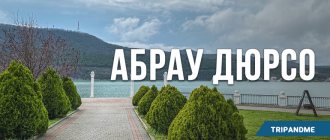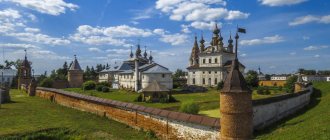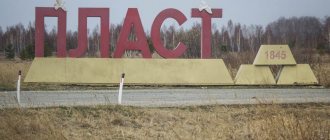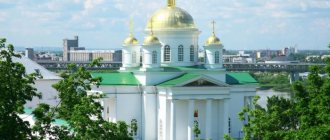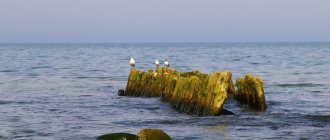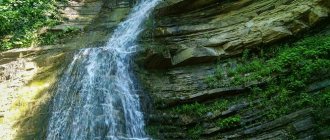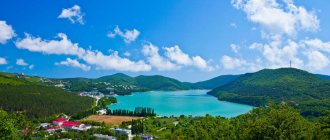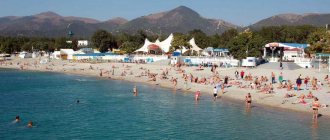Gurzuf is a resort on the southern coast of Crimea, famous for its natural beauty and historical places. The sights of Gurzuf have gained fame not only in Crimea, but throughout Russia. It was here that the dream of all the pioneers of the Soviet Union was located - the Artek children's camp at the foot of the Ayu-Dag mountain.
Young Pushkin came here to rest, here was the dacha of the artist Konstantin Korovin, who often visited Chaliapin, Kuprin, Gorky, Repin, Surikov. In Gurzuf, Chekhov bought a small house for creative retreat on the seashore, escaping his popularity.
What to see in Gurzuf and where to go? Read about the most interesting and beautiful places.
Sights of Gurzuf
Gurzuf is an urban resort village with a population of about 9 thousand people, part of the Yalta urban district. The main attractions of Gurzuf are the beauty of the surrounding nature: picturesque rocks, mountains, the Black Sea. The main symbols of Gurzuf are the Adalary rocks and Mount Ayu-Dag (Bear Mountain). Gurzuf was loved by many artists for its beautiful views; a huge number of films were shot here.
Near Gurzuf, 2 kilometers away is Massandra with the romantic palace of Emperor Alexander III and the famous winery; 22 kilometers away is Alushta, where you can see the Byzantine fortress of Aluston.
Question answer
How to get to Gurzuf 2021?
Gurzuf is part of Greater Yalta. Communication with the “outside world” is carried out through the resort capital of Crimea. Suburban buses depart from the bus station up to 20 times a day. From the airport it is also easier to get to Yalta first, and at the bus station change to a bus to Gurzuf. There are also direct flights, but they are few - 1-2 per day. A taxi from Simferopol to Gurzuf will cost from 1,900 rubles. (see Kiwitaxi.ru).
What sea excursions and walks are there in Gurzuf?
The most popular ones are along the Gurzuf coast. The program is standard: Chekhov Bay, the Genoese rocks, Chaliapin, Adalary, the coast of Artek and Bear Mountains. There are also boat trips from Gurzuf to Yalta, Miskhor, Partenit.
Adalara Rocks
White stone monoliths protruding from the Black Sea are a symbol of Gurzuf. They were once part of the coast, but over time they were cut off from the land due to tectonic movements. They got their name from the Turkish “adalary”, which means “islands”.
There are many legends associated with the rocks. One of the legends says that two rich brothers, George and Peter, used to live in these places. They wanted to win the love of two sisters, took them on a horse ride to get to the Sun, and almost got burned. The next day they decided to disturb the peace of the sea deity. And he cruelly repaid them for this, turning the riders and their horses into sharp rocks.
Divers of these places also have their own legend about countless treasures left over from shipwrecks and resting on the bottom of the sea near Adalar. In ancient times, the islands were a pier when they were still connected to the land by a bridge, so there are still wrecks and fragments of ships in the depths of the sea. In recent decades, amateur divers have actually managed to find amphorae from the 12th-16th centuries and other valuable things here.
Mount Ayu-Dag (Bear Mountain)
Mount Ayu-Dag, 577 meters high, separates Big Alushta and Big Yalta. In appearance, it resembles a bear coming to a watering hole. This is where the name of the mountain came from. Local residents even have several legends explaining its origin. According to one of them, the evil predator ended up in these parts completely by accident, and he was so struck by the beauty of these places that he decided to stay here forever. He lay down at the pond to drink water, and since then he has never risen: the god of the sea turned him into a block of stone.
Bear Mountain is of interest not only to lovers of folklore legends; Ayu-Dag is studied by a variety of scientists. The fact is that there are archaeological monuments here: the ruins of fortress walls and temple buildings. Geologists, examining the mountain, came to the conclusion that it does not consist of ordinary limestone, but of durable igneous gabbrodiabase, i.e. Bear Mountain is an unformed or already extinct volcano. Botanists and zoologists are also studying this area, because more than 600 plant species have already been discovered on Ayu-Dag, and of all the animal species living on the mountain, 16 are listed in the Red Book.
Artek
The history of Artek dates back to June 16, 1925, when a summer tent camp hosted 80 children from different cities. The camp was founded on the initiative of Zinovy Solovyov (1876-1924), chairman of the Central Committee of the Russian Red Cross Society for children with tuberculosis. Gradually the camp turned into an international pioneer camp, the largest and most prestigious in the USSR.
The best pioneers were awarded trips to Artek for excellent studies, behavior, and participation in pioneer activities. Many famous artists, singers, journalists, and scientists visited it. Movies were filmed here, city streets were named after Artek. With the collapse of the Soviet Union, Artek fell into disrepair.
Now it is an international children's center, where children can get free admission for achievements in education, creativity, sports and social activities. The cost of a paid trip is 80 thousand rubles.
Other assets
Other assets that are not included in any of the above lists, but at the same time deserve no less attention, include:
- MDC Artek;
- Suuk-Su Palace;
- Church of the Assumption of the Blessed Virgin Mary;
- Korovin's dacha;
- fountain Goddess of the Night
- gazebo of the winds.
MDC Artek
Children's camp
All children of Soviet times heard about the Artek pioneer camp, and some of them even managed to visit it. Every child dreamed of having a red tie on their chest.
Despite the fact that the pioneer organization has not existed for a long time, the camp continues to operate today. The only thing that has changed is his status. Now it is an international children's center.
The complex occupies an incredibly vast territory, which is divided between several camps. Thousands of children come here from Russian cities and even from other countries. Adults can only observe their lives from the outside and remember their childhood.
Suuk-Su Palace
Suuk-Su
The history of this place dates back to the end of the 19th century. In those days, there lived the famous engineer Vladimir Berezin, who was engaged in the construction of bridges. He decided to buy himself land in Gurzuf and build a luxury resort on it that could compete with foreign treatment centers. The resort opened at the beginning of the last century. When he died, his wife had the opportunity to continue the work, and she did it well.
- On an area of 42 hectares, a bathhouse and a hydropathic clinic were built, around which there was a beautiful park and a beach.
- Separately, it is worth mentioning the luxurious palace, which is a hotel. The building has 3 floors and a snow-white finish. Mosaics, wooden carvings, and fountains were used as decorations.
The new resort was given the name Suuk-Su, which in Russian sounds like “cold water.”
After the revolution, it came under state control. For a long time, party workers rested there, after which a children’s camp was opened. When the Germans captured the peninsula during World War II, a restaurant was opened in the palace. But a year later it burned down during regular festivities. Only 15 years later a decision was made to restore the palace. Today it almost completely reflects the appearance and atmosphere that was inherent in it during its first opening in 1903.
Church of the Assumption of the Blessed Virgin Mary
Architecture of the temple
At the end of the century before last, by order and sponsorship of a local merchant, this cathedral was erected. It is a reflection of the Byzantine style, and expensive Italian marble was used as decoration. Thanks to such a luxurious and rich appearance, it became the hallmark of Gurzuf.
In the 1930s, like most other churches, the temple was destroyed. Restoration work was carried out only in the early 2000s. Today its doors are open to parishioners.
FAQ
What is there to do in Gurzuf?
The resort offers good beach and educational recreation and entertainment.
Korovin's dacha
Entrance to the territory of the dacha.
It is a beautiful villa occupying 2 floors. It was erected by the famous artist Korovin. He loved to spend time in cheerful companies, so there were almost always a lot of people at his dacha. His guests included other creative personalities, for example, Chaliapin, Surikov, Repin.
In the 1910s, Korovin quite often lived at his seaside dacha. This period of his life was considered very successful, because he painted many beautiful paintings.
- During the Soviet period, the house became part of the Artists' Fund. It housed the House of Creativity, where talented Russian painters worked and had a good time.
- In the second half of the last century, luxurious Korovin sculptures made of bronze were installed at the entrance to the house.
- At the beginning of our century, the dacha turned into a simple boarding house, where anyone with a lot of money could stay.
Today, only a small room has survived, serving as a museum, where you can come as part of an excursion group.
Fountain Goddess of the Night
Goddess of the Night
This unique sculpture adorns the local park. Russian craftsmen were able to repeat as accurately as possible the work of the talented German architect.
The sculpture project was purchased at the General Exhibition held in Vienna. It is designed in Baroque style. The plot is based on Greek mythology. Many tourists stop near it to admire its beauty and take memorable photos.
Question to the expert
What time can you come to rest in Gurzuf?
The period from June to the end of September is suitable for a beach holiday.
Pushkin museum
Website: gurzufmuseum.com Address: st. Embankment, building 1. Opening hours: from 10.00 to 18.00, Wednesday until 20.00, days off - Monday, Tuesday. Ticket price: 100 rub.
The building in which the museum is now located is the oldest building made by Europeans on the southern coast of the Crimean peninsula. The building dates back to 1808-1811. The estate owes its appearance to Duke Armand Du Plessis de Richelieu.
In 1820, A.S. Pushkin rested here, who was inspired by the nature of these places and thanks to this he created many famous works, including individual chapters of “Eugene Onegin.”
Now the museum has 6 halls with exhibitions telling about the Crimean period of Pushkin’s life. There is also a memorial office of the Pushkin scholar Tomashevsky, on whose initiative a museum was opened in the estate.
Entertainment
Cafe at the Skalnaya Hotel
Address: st. Leningradskaya, 41 (you can enter the cafe from Artek)
The hotel is located on a cliff directly above the sea. The cafe is located on the territory of the hotel, anyone can enter. The establishment itself offers a wide panorama overlooking the sea. A particularly beautiful view of the mountains and Gurzuf Bay opens from the veranda. But be careful: it’s very high up there, you might get dizzy!
The design of the cafe resembles a modern cave. The walls are stone and untreated, decorated with drawings. The furniture is made of wood, and real torches illuminate the room. The menu presents dishes of European cuisine, but sometimes special signature dishes from the chef are added to it.
The prices in the cafe are not very high. The average bill per person is approximately 200 rubles. The price-quality ratio of the dishes is good.
City Park
Address: st. Leningradskaya, 10 Opening hours: 10.00 - 20.00
Gurzuf Park is located next to the embankment and occupies about 12 hectares. It stretches on both banks of the Avunda River, so the park can be roughly divided in half. One side of the park (the territory of the Gurzuf holiday home) is considered more well-groomed and improved. Almost all the mini-attractions of the park area are located here. On the territory of the city garden there are many sculptures: “Fountain of the Goddess of the Night”, “Bather”, “Nymph” and “Rachel”, “Bear with Cubs”, “Deer at a Watering Place”, “Mother Bathing Children”. There are also several notable and beautiful buildings in the park.
The second half of the park, which belongs to the Pushkino sanatorium. The park area there is more neglected.
The city park is also famous for its abundance of unique plants. Osmanthus, different types of cedar trees, cypresses and other representatives of the flora grow here. The park’s special pride is its olive garden, which still produces good harvests today.
At the moment, the city park is closed; everyone cannot visit it. You can make an agreement at the entrance (you will have to pay about 100 rubles) or get in along with a tour. A ticket for the excursion costs 200 rubles.
Gurzufskaya embankment
The official name is Embankment. Pushkin. The location can easily be called the center of city life in Gurzuf. This is one of the first places where arriving tourists go for a walk. There are many different cafes and restaurants, souvenir shops, children's rooms and other entertainment.
Interestingly, in 1978 the embankment was a venue for performances by the Time Machine group.
Gurzufskaya embankment is a very romantic place. Along its entire length it is paved with marble, which sparkles in the light of lanterns in the evening. Street musicians often play on the embankment, creating a special cozy atmosphere.
Here you can simply walk along the coast, fish (local fishermen say the bite is good), take a ride on an excursion boat or motor ship, go on attractions, or just have a delicious dinner.
Day visit to Mriya Resort & SPA
Address: Yalta, p. Opolznevoye, General Ostryakov Street, 9 Phone: Website: https://mriyaresort.com/dream-day/ Opening hours: Mon-Sun 08:00 - 22:00 Cost (season/off-season):
- Adult with meals – 9,000 rubles/6,000 rubles.
- Adult without meals – 6,000 rubles/3,000 rubles.
- Children's with meals – 6,000 rub. / 3,000 rub.
- Children without food – 3000 rub. / 1500 rub.
Check the exact cost on the website or by phone.
There are an incredible number of interesting and beautiful places in Crimea. You can come here again and again, and there will still be items on your tourist checklist that are a must-see. The large-scale resort complex Mriya Resort & SPA has been one of these places for a long time. Many people know it as a hotel, although you can visit it without staying. Available to all guests and residents of the peninsula.
Relax in the SPA center, swim in the pool, sunbathe on the modern beach, stroll along the paths of the Japanese Garden or try yourself in a rope camp. Sounds like a good plan for a long vacation, but at Mriya Resort & SPA you can get all these experiences in just one day!
“Dream Day” is a day when you can walk around the complex from morning until evening, use its services - there will be entertainment for every family member.
Includes visits to many locations of the complex:
- indoor and outdoor swimming pools
- spa zones: Finnish and cedar saunas, hammam in the SPA center
- beach area
- Japanese Garden "Six Senses"
- gym and scheduled group training
- entertainment center Metropolis
- children's amusement park Dreamwood
- Winepark
- children's club and games room (children over 4 years old are allowed to stay without parents)
- concerts of invited stars, events on the day of the visit (according to the poster on the website)
- meals: depending on the ticket category, meals at the Azurr Swedish line restaurant may be included.
You can also visit one of the 8 bars and restaurants located on the territory of the complex. At your service: European, Italian, Mediterranean, Asian and of course local, Crimean cuisine.
Japanese Garden "Six Senses"
Address: Yalta, p. Opolznevoye, General Ostryakova Street, 9 Phone: Website: Japanese-sad.rf Opening hours: Mon-Sun 08:00 - 22:00 (from September to May - until 20:00) Cost of the excursion: Group excursion - 1500 ₽/person , preferential categories of citizens and children 6–14 — 1,000 ₽/person. Check the entire list of services and tariffs on the website or by phone.
Guests of Crimea, who have already visited various palaces, wineries, parks and other attractions of Crimea more than once, having had enough of them, will be able to get acquainted with and try a completely different format of tourist recreation.
The Japanese Garden of Six Senses is a place for contemplative relaxation and leisurely walks in Crimea.
Six Senses is a three-level, 6-hectare walking garden where guests can see with their own eyes several types of Japanese gardens in one place: a tea garden, a walking garden with a stream and a pond, a dry rock garden, a shady garden and buildings of Japanese architecture.
The pearl of the garden is the open thermal baths overlooking the sea and mountains.
Here, a visitor to the peninsula in search of new entertainment and experiences will be able to discover a new, different type of vacation: thoughtful, contemplative, filled with meaning.
Guests of the garden have numerous opportunities: you can take part in an excursion, take a yoga class, plunge into thermal springs with stunning views of the sea, or enjoy a tea ceremony.
The author of the project is Shiro Nakane, curator of the Imperial Japanese Garden in Kyoto. The garden is located on the territory of the five-star Mriya Resort & SPA. Every year about 25,000 people become its guests.
Bay and Chekhov's dacha
Website: yalta-museum.ru Address : st. Chekhova, 22. Opening hours: from 10.00 to 18.00, days off: Monday, Tuesday. Ticket price with excursion service: 200 rubles, for pensioners, students, schoolchildren over 16 years old - 100 rubles.
The bay is located near the Gurzuf pier, between the Spyglass and Frog rocks. In 1900, Chekhov bought a plot of land here with a saklya for 3 thousand rubles, seduced by the beauty and solitude of these places. It was here that “The Lady with the Dog” and “The Cherry Orchard” were born from his pen. He also brought fertile soil here and planted plants, some of which are still preserved, for example, two bamboo bushes.
After the death of Anton Pavlovich, the dacha was inherited by his wife, O. L. Knipper-Chekhova. And after her death, the building, along with the adjacent territory, went to the Korovin House of Creativity. Since 1987, a small museum has been opened here, belonging to a branch of the Yalta White Dacha.
Korovin's house
Address: st. Chekhova, house 1.
Korovin's house is a three-story building erected on the shores of the Gurzuf Bay in 1910-1912 in the constructivist style. The mansion served as a summer residence for the Russian artist and academician of painting K. A. Korovin. The famous paintings “Portrait of Chaliapin” and “Flower Market in Gurzuf” were created here, as well as his other paintings of sea and city landscapes.
In 1923, when Korovin emigrated to France, the estate came into the possession of the Art Foundation and became known as the House of Creativity. Korovina. Later, 2 buildings were completed. The 14 rooms still retain the spirit of the intelligentsia inherent in the early 20th century. This landmark of Gurzuf still displays reproductions of the artist, as well as his theatrical sketches and drawings.
Suuk-Su Palace
One of the first Gurzuf resorts, owned by the spouses V.I. Berezin and O.M. Solovyova. It was designed and built by architect N.P. Krasnov in the Renaissance style. the Gurzuf landmark was decorated with stucco, columns and figures. The interior was decorated in the spirit of the Moorish style: marble staircase, arches, wooden carvings and multi-colored mosaics on the walls, and the furniture was covered in satin.
After 1917, the palace was transferred to the party. In 1942, the building burned down; in the 50s of the 20th century, it began to be restored. In 1961, the House of Pioneers opened in the renovated palace. Now the premises are located on the territory of the Artek camp and are used to house museum exhibitions.
Holy Assumption Cathedral
Address: Proletarskaya street, building 1.
The five-domed temple in Gurzuf is located near the entrance of the children's health camp "Cypress". Its history began in 1887, when the foundation stone of an Orthodox cathedral was laid on the embankment. So, in 1890, a new temple appeared in Gurzuf, designed in the Greek-Byzantine style by the Moscow architect M. N. Chichagov. In 1935, the cathedral was completely destroyed, and in its place one of the buildings of a military sanatorium appeared.
Only after many years did local residents manage to obtain a new plot of land from the authorities in order to restore the destroyed shrine there. In 2004, construction of the temple began, and already in 2007, the new Holy Assumption Cathedral was consecrated and open to the public.
What else is interesting in Gurzuf
Bonus for those who managed to do everything everywhere:
- The waterfront is a major attraction where all races, ages and modes of transportation mix. Scooters, children, teenagers eating fast food on the go and older people shaking their heads disapprovingly. In the evening, don't forget to bring a flashlight!
- The Holy Assumption Cathedral was originally built at the end of the 19th century under Gubonin, but was dismantled down to the bricks in 1935. Only in 2003 did a beautiful church reappear in its old location.
- The Museum of Magnets is a wonderful, unpromoted place where you can not only see magnets from hundreds of countries, but also learn about the history of Crimea. The owner, who is also a tour guide, costs 150 rubles. will immediately immerse you in the details of the collection.
Of course, while relaxing at sea, it would be a sin not to take a ride on a boat and dive into the depths of the sea:
- from Yalta there is a 2-hour sightseeing walk Yalta-Nikita-Gurzuf-Yalta costing 600/400 rubles. You can get to its 2nd half Gurzuf-Yalta for 450/350 rubles.
- for underwater fish battles and girl-with-a-paddle-style relaxation, check this site for prices and options.
Well, with the car that you prudently rented, there are no limits for you, because nearby:
- Nikita and Nikitsky-Botanical Garden
- Partenit and Paradise Park
- Yalta and our 36-hour guide
Gurzuf Park
A unique park, a monument of landscape art, which appeared in 1803 by order of the Duke of Richelieu on a seaside cliff.
At the moment, its area is 12 hectares, and there are more than 110 species of a wide variety of ornamental plants: from trees to shrubs. Along the perimeter of the park there are sculptural busts of Gorky, Pushkin, Chaliapin, Chekhov and other artists. There are also famous fountains made in the 19th century - “Night” and “Rachel”.
Fountain Goddess of the Night - the flowing splendor of the city
- Address: Leningradskaya street.
This sculpture was purchased especially for the Gurzuf Park in 1889 at the Vienna exhibition by the famous entrepreneur P.I. Gubonin. The naked goddess Nikta with a torch in her hands is located in the center of the composition, with the gods of love and sleep Eros and Hypnos on the sides. Under the feet of the deity a starry firmament with images of the signs of the zodiac is revealed. The entire structure is held by Atlanteans with fish in their hands, from whose mouths jets of water flow. At night, the fountain is illuminated.
Rock Red Stone
Located near the village of Krasnokamenka. The rock got its name due to its unusual appearance - it has a pinkish-yellow hue due to the high content of marble-like limestone. For this reason, the Crimeans nicknamed her “Kyzyl-Tash”, which translated into Russian means “Red Stone”.
Since the Stone Age, this place has served as a stronghold for people. In the Middle Ages, the first patrol fortifications appeared here. The ruins of the Genoese fort that remained on the territory of Kyzyl-Tash have survived to this day.
In 1969, this landmark of Gurzuf was given the status of a natural monument, and a fortified area of 120 by 50 meters was built for tourists.
Assumption Church and Mount Balgatura
From “Chekhov’s dacha” go back the same way, just turn right into the alley and up the steps, past the “Sommelier” cafe (not bad by the way, you can stop by if you want) and go up to Leningradskaya Street.
This is a very atmospheric and photogenic, cobblestone pedestrian street of Gurzuf with many shops and practicing street artists:
We suggest following it to the right, to our next attraction in Gurzuf - the active Assumption Church, if you are interested in religions and architecture.
And a 15-20 minute walk from the church is the highest point of the village - Mount Balgatura. You'll have to walk up the hill, but we highly recommend climbing it anyway - from the observation deck at its top you can see magnificent views of the sea, mountains and roofs of Gurzuf.
We recommend : unusual excursions around Yalta
Well, on the way back you can capture a little of the atmosphere of the village: its streets in the center. From Balgatura go down Orekhovaya Street, then Podvoisky Street. At the junction of Podvoisky, Svoboda and Vagul streets there are a lot of close, photogenic places. Well, going down, you will inevitably come out onto the pedestrian part of Leningradskaya Street that we have already mentioned.
Moving along it to the right, you will come to the Gurzuf “patch” near the fountain - the busiest part of Gurzuf, where a lot of cafes and restaurants, shops and pharmacies, burger joints and coffee shops are concentrated, where young people hang out and street musicians and artists create:
Time to visit : ~1.5-2 hours • cost : if desired, pay only for souvenirs, cuisine, wine or coffee.
Useful information: what to do in Yalta during rain
Chaliapin's Rock (Sultanka)
In 1916, Fyodor Ivanovich Chaliapin, a Russian opera and chamber singer, often visited his friend, artist K. Korovin, in Gurzuf. He was captivated by the beauty of the village and its surroundings, so he decided to build his castle of arts here. For these purposes, he liked the rock, which at that time was called Pushkin Rock or Sultanka Rock. The owner of this land, Olga Mikhailovna Solovyova, sold it to Chaliapin for just 1 ruble, captivated by Fyodor Ivanovich’s singing.
Architect I. A. Fomin completed the plan for the singer's future castle on the rock, but they were unable to build it due to the 1917 revolution. Now this place is called Chaliapin’s Rock by local residents, and its territory belongs to the Lazurny children’s camp.
Dzhenevez-Kaya rock and Gorzuvita fortress
In the 6th century, the Byzantine Emperor Justinian I ordered the construction of fortifications in these places, which were later named Aluston and Gorzuvita. They were supposed to protect the Byzantines from barbarian attacks. Gorzuvita served as a defense for the sea and land routes near Gurzuf Bay on the Dzhenevez-Kaya rock.
The fortress fit into the natural terrain: the tops of the rock were used as towers, and the cliffs as foundations for fortifications.
Until the 15th century, Gorzuvita changed owners several times. The strategic object was captured at different times by the Theodorians, Khazars, Turks and Genoese. Only the remains of the structure have survived to this day. These include the foundations of internal buildings and part of the defensive perimeter with gates. The former fortress is now located on the territory of the Artek children's camp.
Gazebo of the winds
5 km from the village, on the top of Mount Shagan-Kaya, there is a gazebo of winds. Its height above sea level is 1545 meters. Wind gusts here reach 40-45 m/s, but durable structures allow them to withstand extreme climatic conditions. According to legend, the gazebo was built just a few days before N.S. Khrushchev’s arrival in Yalta in 1956.
The building is a marble colonnade of 8 columns 5.5 meters high, which are topped with a dome, and a spire is installed on the cornice. The floor is decorated with multi-colored marble and depicts the Compass Rose diagram.
Where to go with children
Be sure to visit Gurzuf Park. The diversity of nature, beautiful fountains and sculptures are excellent reasons to spend time with your family. The city beach and embankment of Gurzuf, sea air, crystal clear water and a variety of entertainment will not let you or your children get bored.
If you have a car, be sure to visit the Wind Arbor . The road is long, so getting there by public transport and then walking can get very tired. But in any case, you and your children will be delighted to see the world from a bird's eye view.

